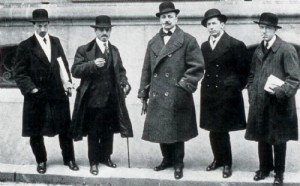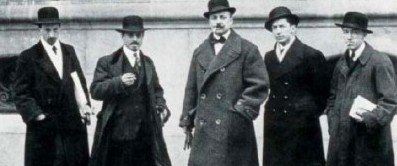Futurism Contemplated: Is Futurism Proto-Punk?
FUTURISM CONTEMPLATED
by Karen PINKUS
In many ways, Italian Futurism could be considered an unacknowledged precursor to punk.
The Futurists were members of the Italian bourgeoisie. Punks were working class, but both movements shared a disdain for high culture, for detatched bohemian/hippie art, and for lethargy or nostalgia. Marinetti wrote his founding manifesto of the Futurist movement in 1909 and quickly found a following in a group of painters, sculptors, poets, dramatists, architects, and musical innovators– including Carlo Carra, Umberto Boccioni, Luigi Russolo, Giacomo Balla, Antonio Sant’Elia, Fortunato Depero, and many others.

Filippo Tomasso Marinetti, Umberto Boccioni and Gino Severini.
The aim of the movement was to utterly transform the passe and anachronistic society of Liberal, parliamentary Italy. To drive Italy into the future, Marinetti’s first manifesto extols speed, virility, technology, and war. In a brilliantly calculated move, he published the manifesto on the front page of the most respectable newspaper in Europe, Le Figaro. This line sums up Marinetti’s whole aesthetic program: “A speeding car is more beautiful than the Victory of Samothrace.”
Futurism created an immediate mass scandal, and the members of the movement began to organize “evenings” (happenings) that combined drama, music, politics, provocation, and assault on the audience. The performances were violent, and as the Futurists gained notoriety throughout Italy, they were stalked by a sizable police presence which only helped to further arouse the curiosity of the spectators. The Futurists traded insults with respected members of the town they visited, objects were thrown on stage, and performers and spectators engaged in gobbing, an act that later became a punk trademark (although according to John Lydon, nee Rotten, it all started not as a planned program to break down traditional performer/spectator boundaries, but because of his sinusitis).
For Marinetti, the term Futurist specifically suggested forward motion and speed, and he used it in opposition to “armchairism”, his concept of the home-bound bourgeois patron of the fine arts. So although the unrealized (and unrealizable) drawings of architect Antonio Sant’Elia, for example, appear “futuristic” in our sense of a science fiction of utopia, the movement was not particularly concerned with fantasy so much as with the exploitation of available technology. Marinetti loved cars. After World War I, the Futurists conceived of “aeropainting”, a mode of representing the world as it would appear from the cockpit of a speeding plane.
Marinetti hated art museums, universities, and pasta (“It weighs you down like a ball and chain”). He advocated a diet based on pills, which he hoped might one day be broadcast over the radio waves into every home. He orchestrated special Futurist dinners featuring dishes like Ball Bearing Chicken. The Futurists practiced a D.I.Y. form of production and distribution; they tore up newspapers to make violent proclamations, and they also had their own printing press. Some Futurists manufactured toys and clothing that bore the official stamp of the movement.
It might be possible to see parallels between Marinetti and Malcolm McClaren. Both men had large egos and positioned themselves as the fathers of their respective movements. Marinetti, however, maintained a greater degree of control over the spread of Futurism in the end because he worked from inside Futurism, rather than standing outside and above.
Like Punk, Futurism lived a brief period of energetic “actuality”, marred by the tragic deaths of major protagonists. The Futurists eagerly enrolled in the Lombard Volunteer Cyclist Battalion, the Italian “speed” division during WWI. Marinetti suffered a hernia, Russolo was quickly injured, and thirteen other Futurists were killed during the war. After an initial burst of innovation, both Futurism and Punk continued on for many years in a (watered down?) version in which the movement names were ironically appropriated as marketing tools.
